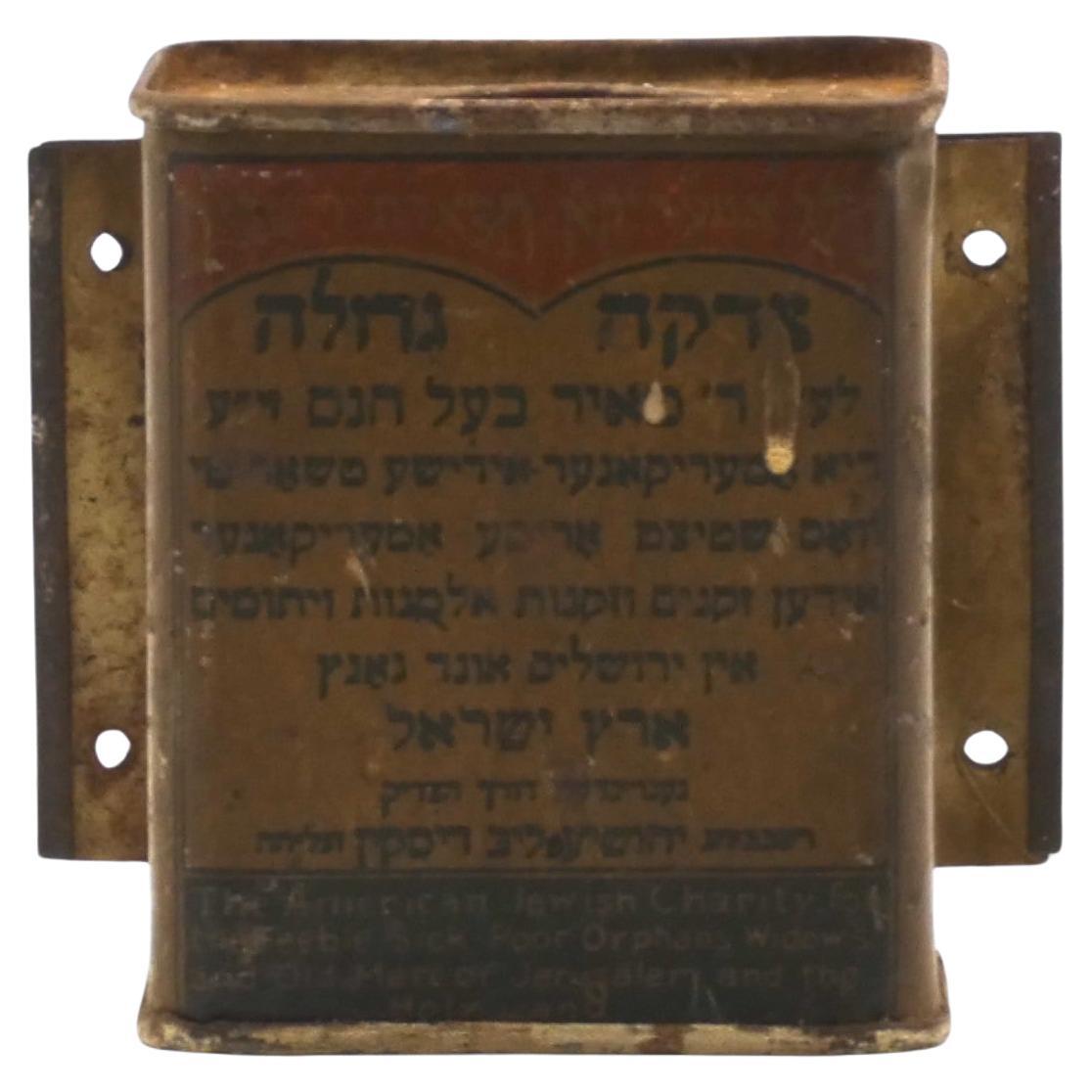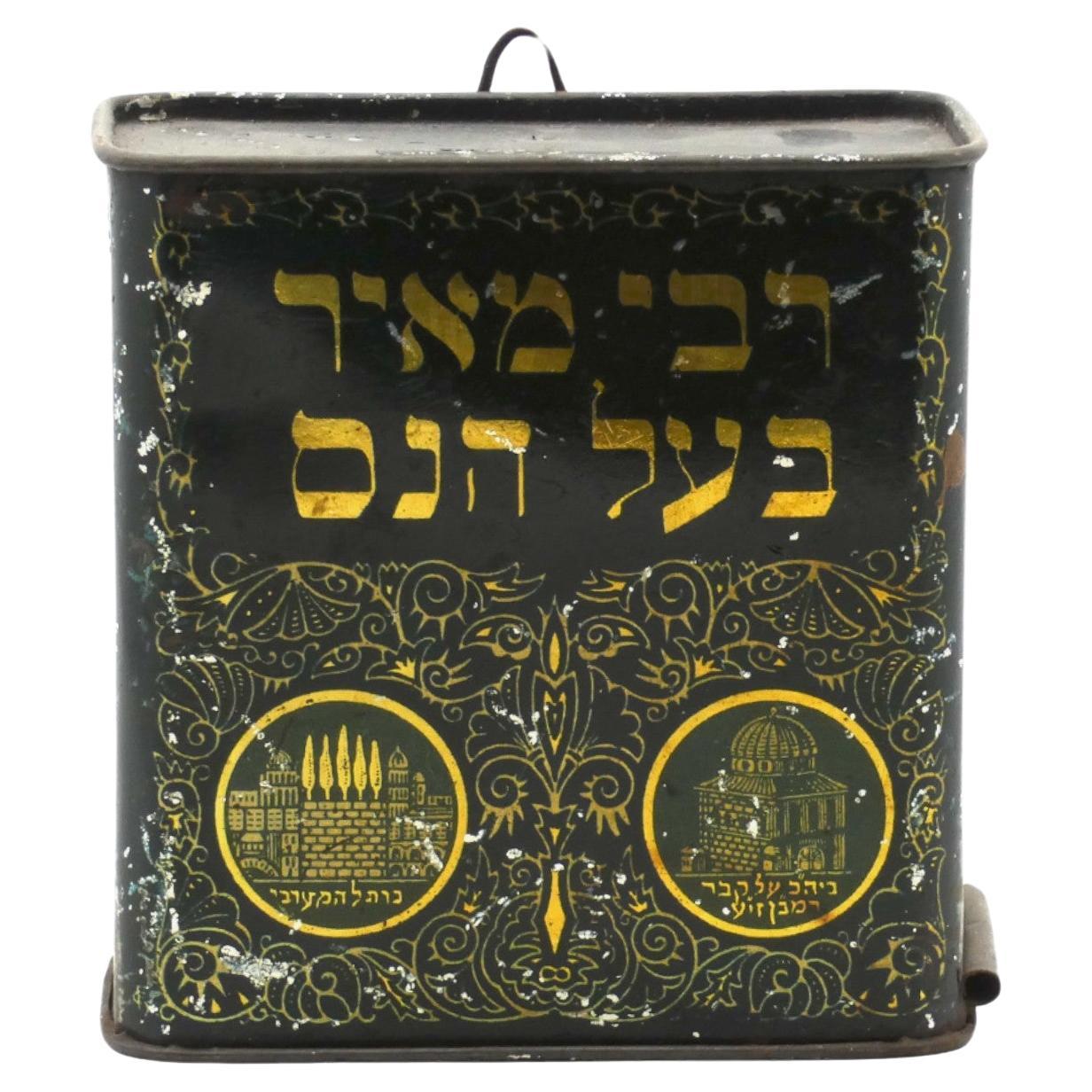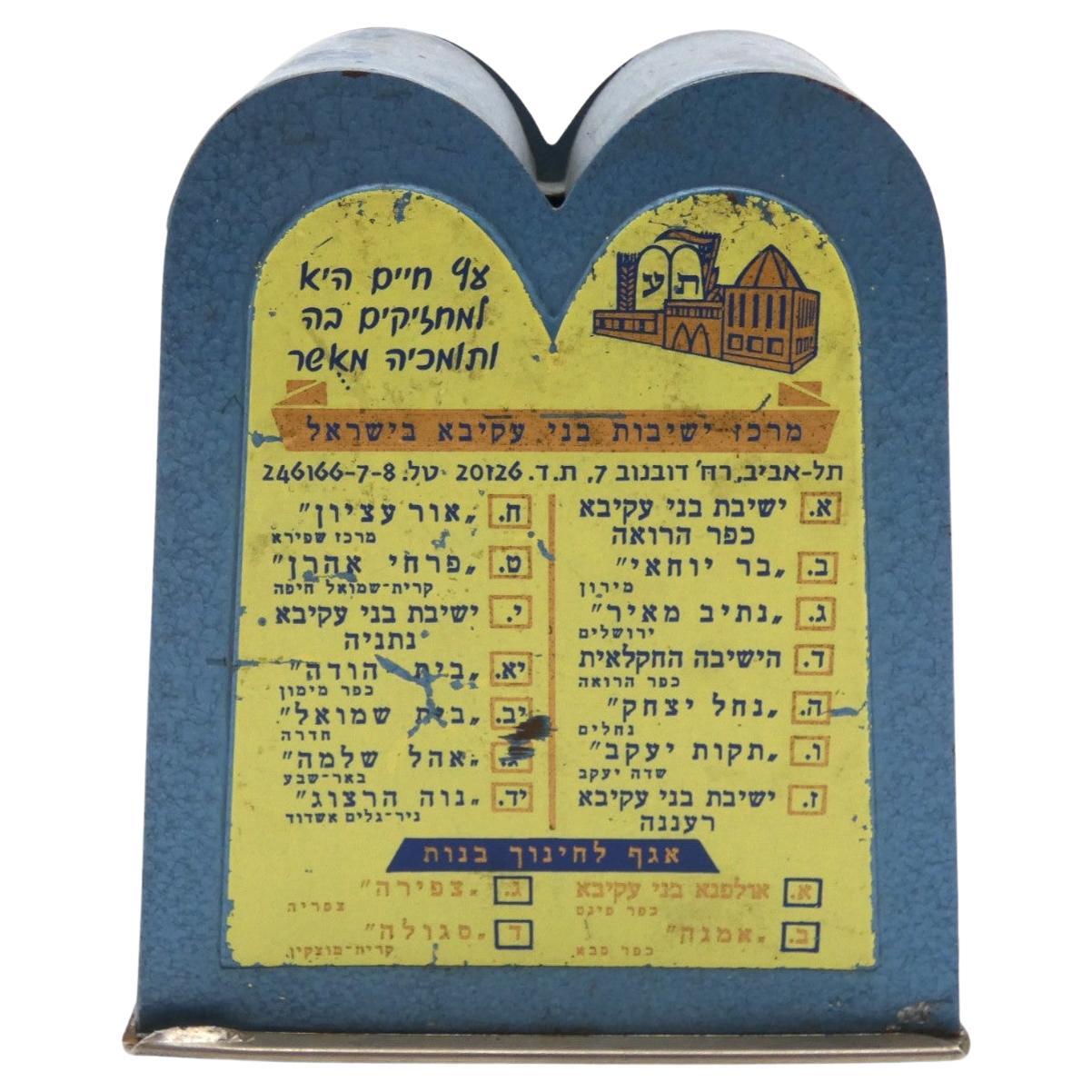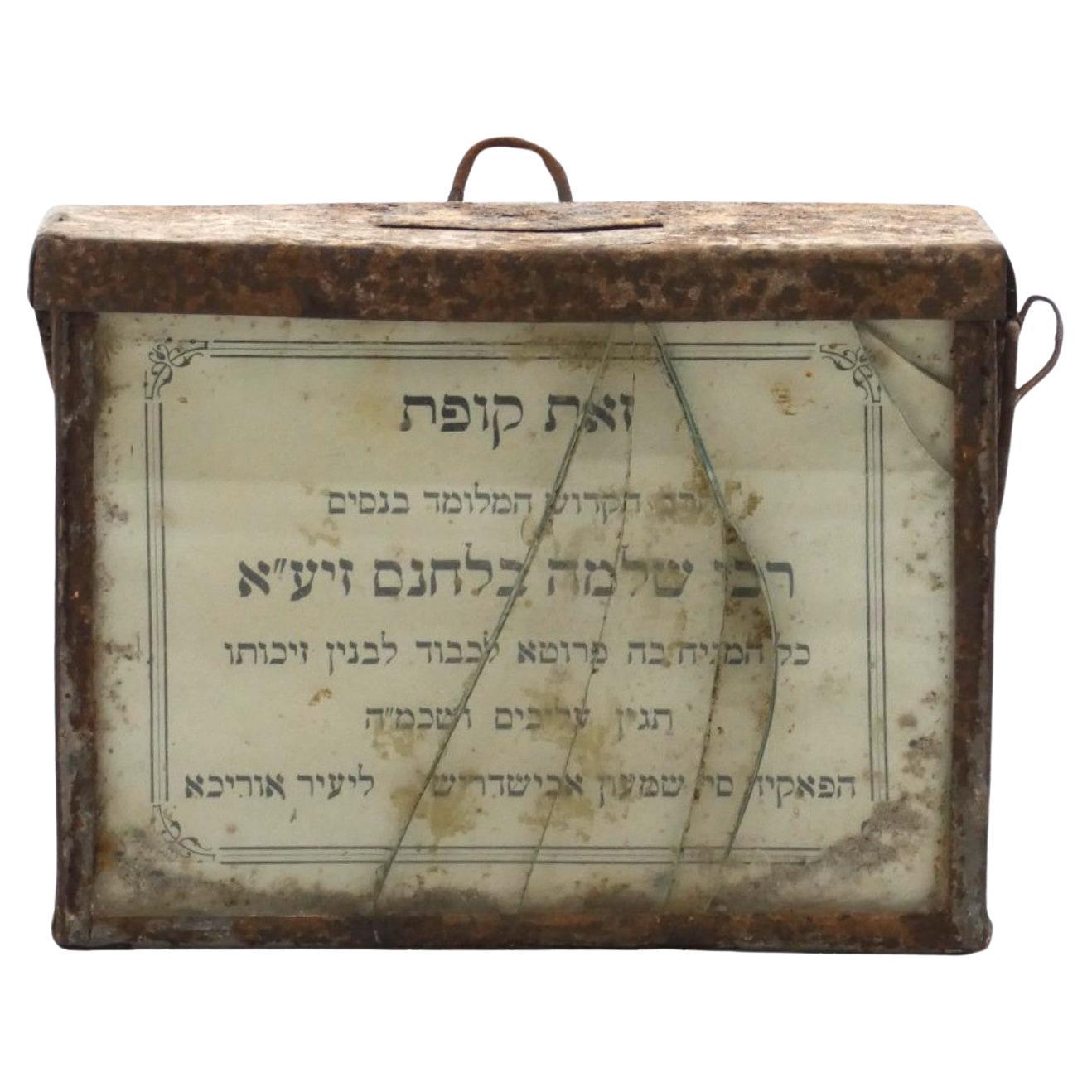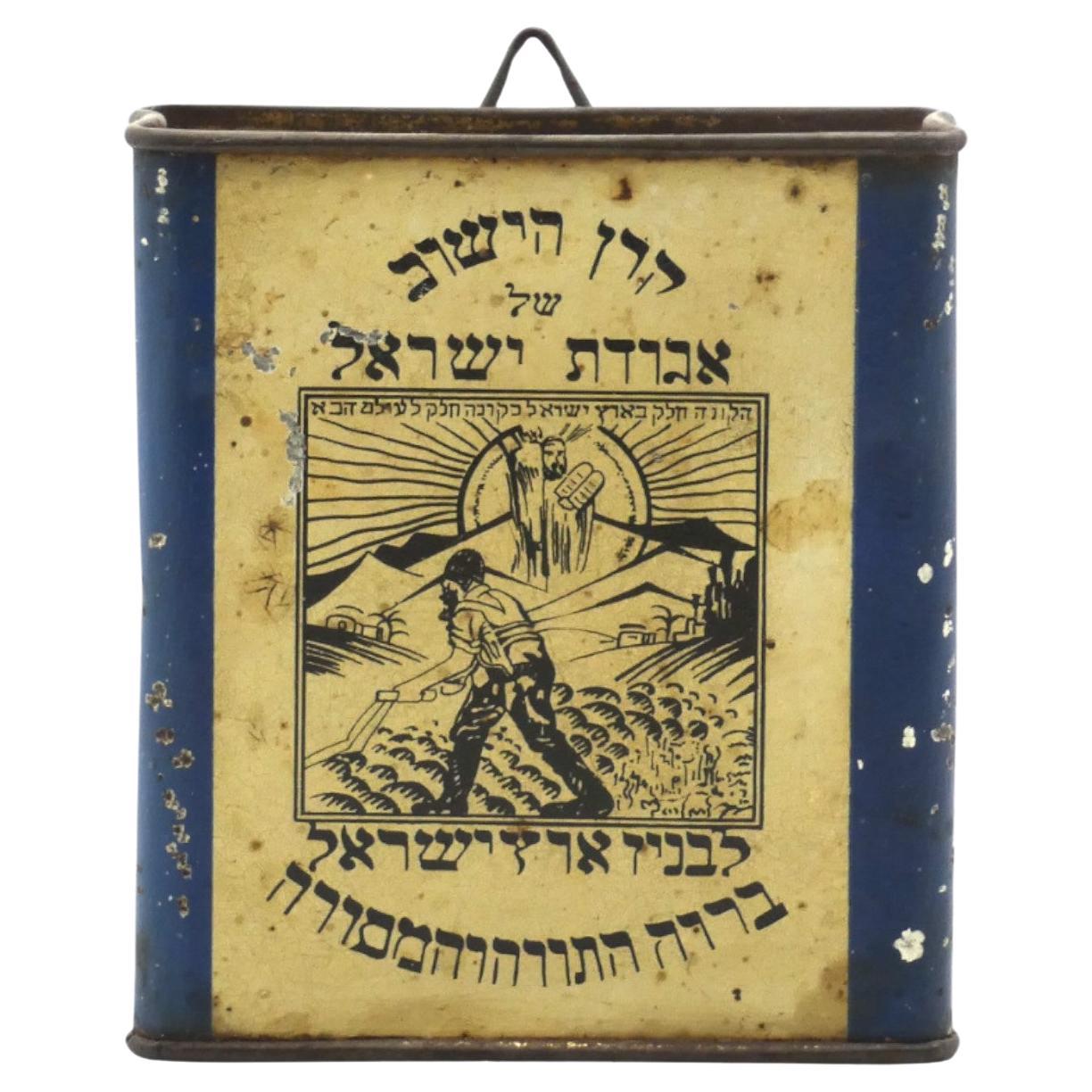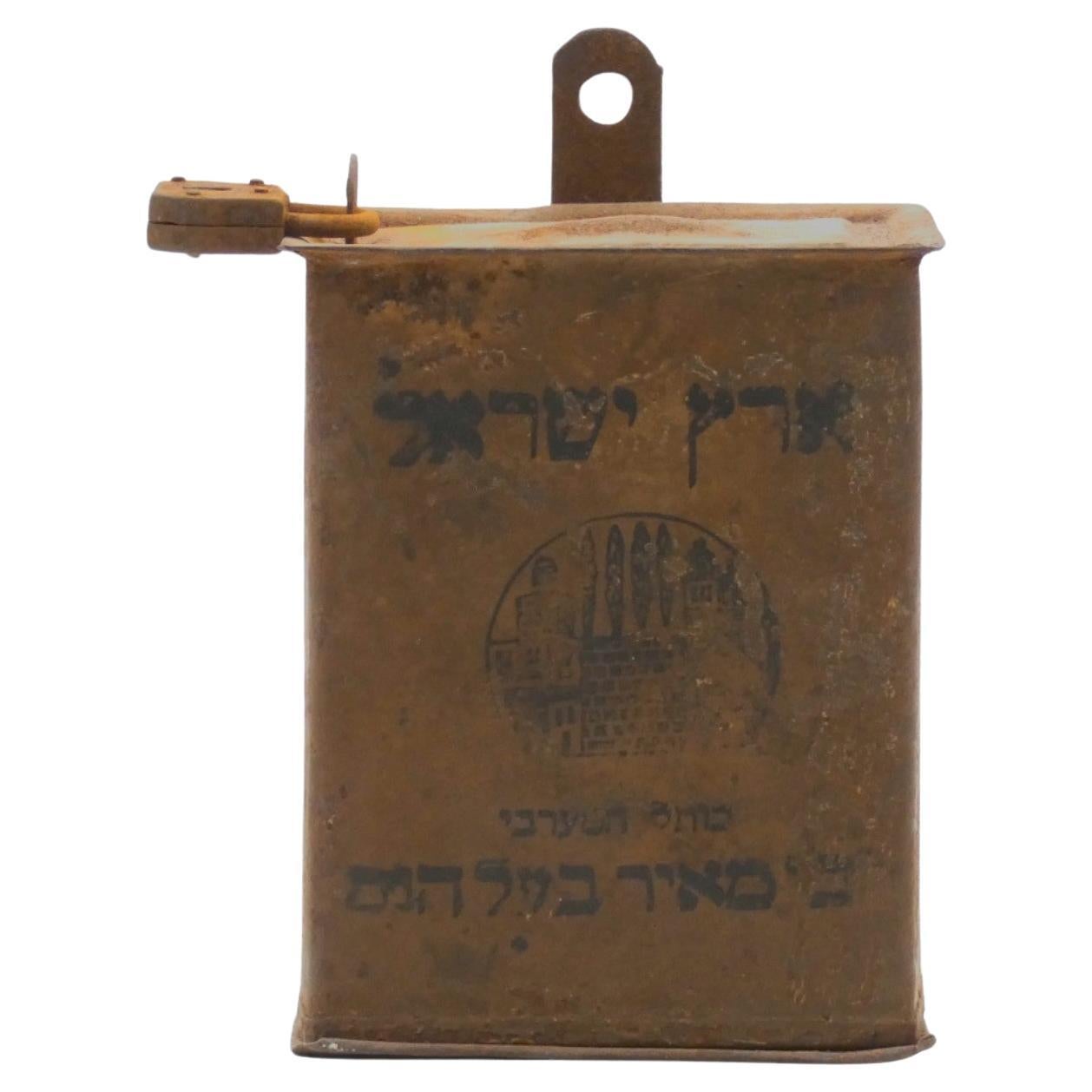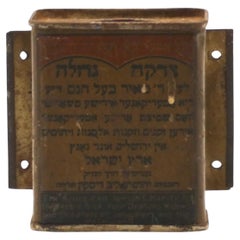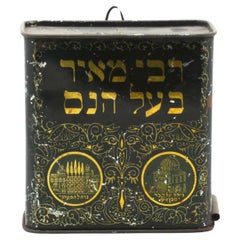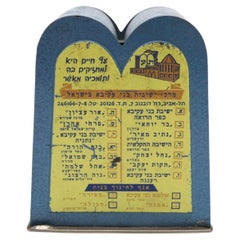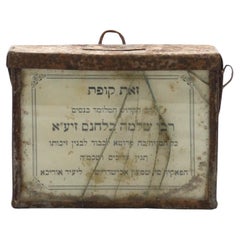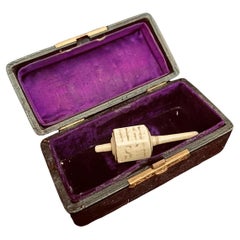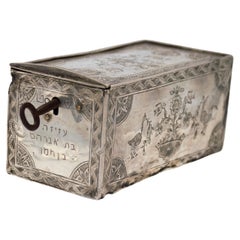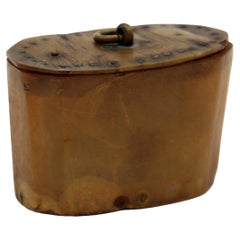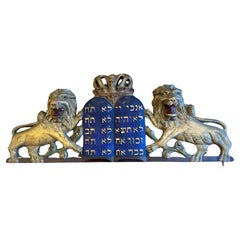Items Similar to An Early Charity Container from an Agudath Israel Convention
Want more images or videos?
Request additional images or videos from the seller
1 of 7
An Early Charity Container from an Agudath Israel Convention
$3,200
£2,429.84
€2,778.70
CA$4,470.86
A$4,972.58
CHF 2,596.53
MX$60,510.97
NOK 33,161.59
SEK 31,099.72
DKK 20,738.49
Shipping
Retrieving quote...The 1stDibs Promise:
Authenticity Guarantee,
Money-Back Guarantee,
24-Hour Cancellation
About the Item
This unique vintage pushka (charity box) is a rare historical piece from an Agudath Israel convention held in early 20th-century Europe, possibly near Switzerland. The design and inscriptions suggest that it was distributed to attendees as a keepsake and functional charity collection box.
The pushka is made of tin, crafted by the European company Gebr. Hoffman, which began producing tins in 1904 in Thun, Switzerland. The two halves of the box fit together seamlessly, ensuring a secure closure. One side features an embossed design resembling an early 20th-century Swiss coin, with a large "1" encircled by a laurel wreath. Below the number, a narrow slit allows for the insertion of coins, making it a practical donation container.
The reverse side of the tin bears an inscription that reads:
"Histadruth Olamith N'Schel Uwenoth Agudath Israel 'Nowaj'"
This text signifies its connection to the global Agudath Israel movement and its charitable initiatives.
Given its historical significance, craftsmanship, and connection to an important Jewish organization, this pushka box is a fascinating artifact that reflects both European Judaica and the early 20th-century Agudath Israel movement.
- Dimensions:Height: 1.19 in (3 cm)Width: 3.35 in (8.5 cm)Depth: 3.35 in (8.5 cm)
- Materials and Techniques:
- Place of Origin:
- Period:
- Date of Manufacture:20th century
- Condition:Wear consistent with age and use.
- Seller Location:New York, NY
- Reference Number:1stDibs: LU5281243609232
About the Seller
5.0
Recognized Seller
These prestigious sellers are industry leaders and represent the highest echelon for item quality and design.
Established in 2006
1stDibs seller since 2020
130 sales on 1stDibs
Typical response time: 1 to 2 days
- ShippingRetrieving quote...Shipping from: Pomona, NY
- Return Policy
Authenticity Guarantee
In the unlikely event there’s an issue with an item’s authenticity, contact us within 1 year for a full refund. DetailsMoney-Back Guarantee
If your item is not as described, is damaged in transit, or does not arrive, contact us within 7 days for a full refund. Details24-Hour Cancellation
You have a 24-hour grace period in which to reconsider your purchase, with no questions asked.Vetted Professional Sellers
Our world-class sellers must adhere to strict standards for service and quality, maintaining the integrity of our listings.Price-Match Guarantee
If you find that a seller listed the same item for a lower price elsewhere, we’ll match it.Trusted Global Delivery
Our best-in-class carrier network provides specialized shipping options worldwide, including custom delivery.More From This Seller
View AllA Kollel America Charity Container, New York Circa 1930
Located in New York, NY
A Kollel America Tiferet Jerusalem Charity Container from New York circa 1930 is tied to the charitable activities of Jewish immigrant communities in America raising donations for ca...
Category
Early 20th Century American Religious Items
Materials
Tin
$720 Sale Price
20% Off
A Rabbi Meir Ba'al Haness Charity Container, Israel Circa 1920
Located in New York, NY
A Rabbi Meir Ba'al Haness charity container from Israel circa 1920 is an artifact associated with Jewish religious devotion and charitable traditions.
Rabbi Meir Ba'al Haness, also ...
Category
Vintage 1920s Israeli Religious Items
Materials
Tin
$1,440 Sale Price
20% Off
A Charity Container for the Bnei Akiva Organization , Israel 1950
Located in New York, NY
A charity container for the Bnei Akiva organization in Israel from around 1950 reflects the ethos and activities of this prominent religious Zionist youth movement.
Bnei Akiva is a ...
Category
Vintage 1950s Israeli Religious Items
Materials
Metal
$1,120 Sale Price
20% Off
A Moroccan Charity Container, Circa 1920
Located in New York, NY
This Moroccan charity container from around 1920 is a unique artifact that represents the containers that were often used for collecting donations or contributions for various charit...
Category
Vintage 1920s Moroccan Religious Items
Materials
Tin
$2,000 Sale Price
20% Off
A Keren Hayeshuv Charity Container, Israel Circa 1940
Located in New York, NY
A Keren Hayeshuv charity container from Israel circa 1940 is an artifact tied to the early years of the State of Israel and its efforts to support Jewish settlement and development.
Keren Hayeshuv, which translates to "The Settlement Fund," was an organization established in Israel during the pre-statehood period and continued its activities after the establishment...
Category
Vintage 1940s Israeli Religious Items
Materials
Tin
A Metal Israeli Kotel Charity Container, 1910
Located in New York, NY
A Rare Metal Israeli Kotel charity container for Rabbi Meir Baal Haness from 1910 tied to Jewish religious and charitable traditions.
Rabbi Meir Baal Haness, also known as Rabbi M...
Category
Vintage 1910s Israeli Religious Items
Materials
Metal
$2,000 Sale Price
20% Off
You May Also Like
Antique Rare Judaica Dreidel Germany 19th Century
Located in Doha, QA
An absolutely unique Bone Dreidel originated from Germany in 19th century. It has six sides shaping Star of David. Each side has one or two Yiddish letters on top which refer to an O...
Category
Antique 19th Century German Religious Items
Materials
Bone
extremely rare Algerian Judaica silver, jewish Dowry box early 19th century
Located in Tel Aviv - Jaffa, IL
Amazing and scarce JUDAICA object, we have here one of the most touching jewish objects we had for a long time, this small silver dowry box was made in Algeria in the early 19th century, it is all covered with symbols of jewish faith and of couples, the sliding lid has 2 flanking birds with hamsa (protective hand) on each side and a flower vase in the middle.
one side shows two flanking lions with a tree in the middle and the other side shows again two big and two small birds with a flower bowl in the middle, front side has a key hole and next to it there is the Hebrew inscription ס״ט״" which says Siman tov or in English "a good sign" it is taken from the wedding blessing, underneath the lock there is another inscription with the name ״עזיזה בת אברהם בן חמו״ which is the name of the bride, her father and her grandfathers name.
the box is full marked a lot of times with the silversmith mark, every side of the box is marked.
this box was probably ordered by the grooms family to hold the jewelry they are giving to the bride as dowry, this type of objects are rare and there are just a few of them on museum collections.
DOWRY (Heb. נְדֻנְיָה), the property a wife brings to her husband at marriage; the Yiddish equivalent, nadn, is from the same root. The custom of nedunyah became clearly defined and institutionalized only in the talmudic period. In biblical times, mohar (מֹהַר), whereby the groom bought his wife from her father (Gen. 24:53; Ex. 22:15–16; Hos. 3:2), was the accepted practice. It was then customary that the groom give the bride gifts, and that she bring certain property to her husband's home upon marriage: slaves, cattle, real estate, etc. (cf. Gen. 24:59–61; 29; Judg. 1:14ff.; I Kings 9:16). Evidence of the custom of nedunyah is to be found in Tobit (7:14; 8:21) and in the Assuan papyri (Cowley, Aramaic, nos. 15, 18). Gradually, mohar was superseded by the ketubbah custom according to which the husband merely assumed the responsibility of compensation to his wife in case he divorced her: he had to pay her 200 zuzim if she had been a virgin at the time of marriage, and 100 zuzim if a widow or divorcée (see *Ketubbah).
By talmudic times, the institution of nedunyah was prevalent; the father gave a dowry to the bride since the daughter was excluded from paternal inheritance. Fifty zuzim (equivalent to the worth of 180 grams of silver) was the minimum amount a father was obliged to give to his daughter (Ket. 6:5). Parents usually gave much more, according to their social standing. Community funds provided the dowry for an orphan or a very poor girl (ibid.; cf. Sh. Ar., YD 251:8). In case of her father's death, the brothers of a minor girl were obliged to give her the minimum dowry, and the court estimated how much her father would have given her above the minimum dowry. The sum was then taken out of the father's estate and given to the daughter upon majority (Ket. 6:6; 68a–69b). In the absence of such an estimate, each daughter was entitled to receive one-tenth of the value of her father's estate in money, or in valuables (Yad, Ishut, 20:4–7; Sh. Ar., EH 113:4). If the father was unable or unwilling to pay the promised dowry at the betrothal ceremony, the groom could refuse to marry his bride (Ket. 13:5; Ket. 108b–109a). Insistence on exact payment of the promised dowry, however, was frowned upon by later rabbinic authorities (Rema to Sh. Ar., EH 2:1). In certain communities it was customary for the groom's father to make a dowry contribution equal to that of the bride's father (Ket. 102b). The dowry, whether given in real estate, slaves, money, or chattel was recorded in the marriage contract (the ketubbah) and in some instances one-third or one-fifth of the actual value of the dowry was added to the sum mentioned in the ketubbah. Based upon a decree enacted by *Simeon b. Shetah (first century C.E.), the Talmud ruled that the husband and his entire property were liable for compensation as stipulated in the ketubbah, either in case he died (when she collected the sum specified in the ketubbah from the heirs) or in case he divorced his wife (Ket. 82b). For the status of the dowry and the husband's rights and obligations, see below. The rabbinic enactments (Takkanot Shum) by R. Jacob *Tam and by the rabbinic synod of the communities of Speyer, Worms, and Mainz (Germany) stipulated that if a woman died...
Category
Antique Mid-19th Century Algerian Tribal Art
Materials
Silver
1800s Snuff Box of Ram's Horn and Wood
Located in Chapel Hill, NC
c.1800s snuff box, ram's horn with wood inset bottom. Base edge faults in the horn-top edge also. With a tag: "You God Father Eckhadt (?) snuff box" and description. 2 3/8" x 1 3/8 x...
Category
Antique 19th Century English Arts and Crafts Snuff Boxes and Tobacco Boxes
Materials
Wood
$85 Sale Price
41% Off
Judaica: An Antique American Decalogue
Located in Montreal, QC
This unusual pediment is from the top of an ark, it is original down to the pegs that would attach it except a very minor refreshing of the blue paint. The tablets are carved in r...
Category
Antique Late 19th Century Sculptures and Carvings
Materials
Pine
Antique Gothic Judaica Box with Kabbalistic Seals and Sacred Texts
Located in Doha, QA
This rare and evocative Medieval Gothic box contains a powerful combination of Salomon’s Kabbalistic seals, a sacred ex libris dedicated to God, and a Star of David inscribed with He...
Category
Antique 15th Century and Earlier German Renaissance Religious Items
Materials
Wood, Paper
Rare Antik Judaic Kiddush Cup Medieval Period
Located in Beuzevillette, FR
Very rare small Judaic cup from medieval period used for the Kiddush ceremony and also probably for circumcision. This chiseled bronze cup is decorated on its belt, with Hebrew characters. The back of the cup is decorated with the Star of David. The whole has a beautiful old patina.
This object with certain oriental influences, probably comes from medieval Spain...
Category
Antique 15th Century and Earlier Spanish Islamic Religious Items
Materials
Bronze
More Ways To Browse
Antique Container
Antique Containers
Antique Furniture Containers
Rare Antique Tins
Antique Charity Box
Donation Box
Antique Donation Box
Silver Mezuzah
Antique Bible Stand
Used Liturgical Items
Antique Silver Spanish Cross
Holy Water Font
Religious Chalice
Church Relic
Plaster Jesus
Russian Orthodox Icon
Wooden Crucifix
Italian Tabernacle
